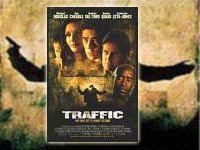Traffic (Steven Soderbergh, 2000)

Rewarded with four Oscars, Traffic may be one of the best-remembered films from the last year of the last century. Directed by Academy Award winner Steven Soderbergh, the movie interweaves three stories to display the complex and terrifying efficiency of the drug trade in America. As the drugs, in this case heroin, move from producer through distributor to user, they provide a constant stream of death and destruction for Americans and their culture. If the statistic that is used in the film is even close to accurate—that 25% of American teenagers use drugs other than alcohol—then we face a monstrous problem in this country. Seeing Traffic is a must, if you care about that problem…or that country.
Traffic does not presume to judge the attempts at solving the drug problem in America, nor does it offer any fool-proof solutions to that problem. In a chilling scene midway through the film, Robert Wakefield, a judge from Ohio who has just been appointed the new drug czar, flies to Mexico to examine the U.S. drug enforcement agencies’ efforts first-hand. While they are enroute back to Washington, Wakefield, played by Michael Douglas, conducts a brain-storming session, asking his staff for “new ideas, fresh approaches.” The absolute, stone silence and the frustrated, blank stares of everyone on the plane speak for the film’s rigorous insistence that there is no solution coming from the enforcement side of the government’s involvement.
What of the legislative side? A classic, Washington cocktail party scene, including real Senators from both sides of the fence to emphasize the point (Barbara Boxer of California and Orrin Hatch of Utah have cameos), puts forth as many views as there are in the country about what needs to be done. One law-maker advocates stricter penalties for distributors, another wants more education of school children, another greater international cooperation, another legalization. Wakefield wanders from conversation to conversation in a daze, sarcastically remarking to his wife and daughter when he gets back home that Washington is full of bureaucrats who have no idea how to solve the problem.
Much has been made of the movie’s semi-documentary style, and it is effective in undergirding the idea that, while the story is fictional, the movie nevertheless gives a punishingly true picture of the drug trade in America. The scenes in the countryside of Mexico, centering around a seedy drug compound, are yellowed out and often shot at 18 frames-per-second speed (rather than the normal 24) in order to reinforce the antiquated equipment and methods of the police in Mexico, as well as the primeval barbarism of the torturers, be they soldiers or drug-producers (or both!). Soderbergh does a remarkable job of orchestrating the portrayals of the separate elements of the business in such a way that the audience keeps the three stories distinct, while regularly acknowledging that they are intimately connected. Often we see devices like a tracking shot of a car containing a character from the “user story” passing along the street, when the camera suddenly stops and zooms slowly in on a character from the “distributor story” sitting at an outdoor restaurant.
Weaving the tales back and forth, Soderbergh (and his similarly Oscar-awarded editor, Stephen Mirrione, and screenwriter, Stephen Gaghan) depicts almost everyone in the movie both sympathetically and realistically. This has a disturbing effect on the viewer because it more than ever forces us to realize how “normal” people who are involved with drugs might appear. In one scene, a beautiful and very pregnant Catherine Zeta-Jones delivers lemonade; in the next she is screaming into a cell phone for her hit man to shoot a witness in the head. In a brilliant, horrifyingly real portrayal, ingenue Erika Christensen sits around in one scene talking with her friends about parents and relationships like any other sixteen year-old prep school girl; soon, she becomes the strung-out love-slave to a drug-dealer, unable to move from her dilapidated hotel room.
Traffic has few flaws. Some will fault the Zeta-Jones character for changing so quickly from an innocent, southern California, socialite with two small children to a ruthless killer, but, sadly, I bought the character completely. If your life is built on money and social status, what might you not do to preserve it, especially when you find out that the man you love is a drug dealer? Christians will be struck with the depressing lack of hope at the end of the film, but one can hardly blame a realistic, secular portrayal of this problem for being depressing, especially if it seeks to be fair to the subject matter. The Drug Enforcement Agency, for instance, is shown as full of self-sacrificial public servants, but their goodness only functions as a stimulus to the audience’s frustration with the immensity of the problem. If good people are going to keep dying, and the problem is only going to get worse, what’s the point?
Christians must remind themselves that this world is not our home, but it is a place God cares about, and so we must care about it, too. Just because we are not affected by the drug trade does not mean it is not our problem; we have a mandate from the king to bring justice and righteousness into every corner of the world. Traffic will help those of us who do not know, and certainly do not want to know experientially, what drugs are all about to gain a perspective on this devastating social disease, and for that we can be thankful.
Traffic credits:
Starring:
Michael Douglas (Robert Wakefield)
Don Cheadle (Montel Gordon)
Benicio Del Toro (Javier Rodriguez)
Luis Guzmán (Ray Castro)
Dennis Quaid (Arnie Metzger)
Catherine Zeta-Jones (Helena Ayala)
Steven Bauer (Carlos Ayala)
Jacob Vargas (Manolo Sanchez)
Director: Steven Soderbergh
Screenwriter: Stephen Gaghan
Producers: Laura Bickford, Marshall Herskovitz, Cameron Jones and others
Cinematographer: Steven Soderbergh
Costumes: Louise Frogley
Original Music: Cliff Martinez
Runtime: 147 minutes
Rated R for pervasive drug content, strong language, violence and some sexuality

